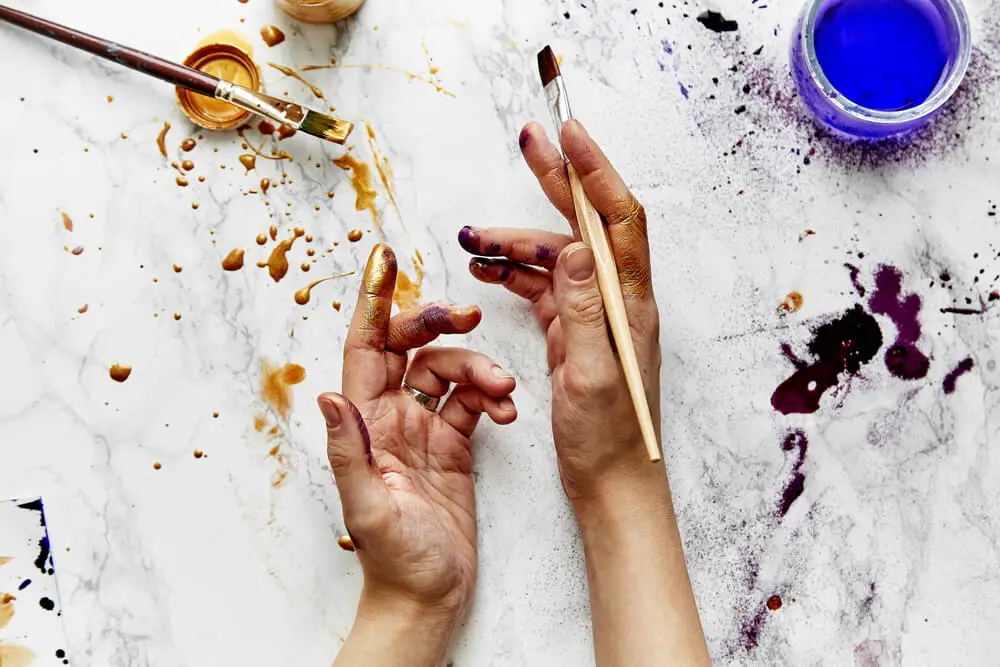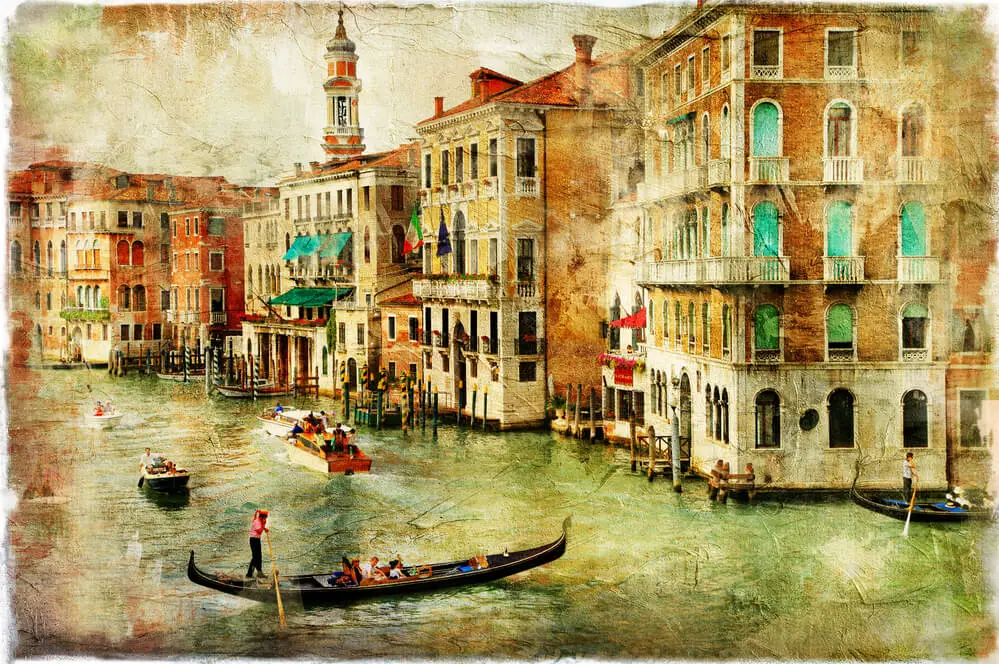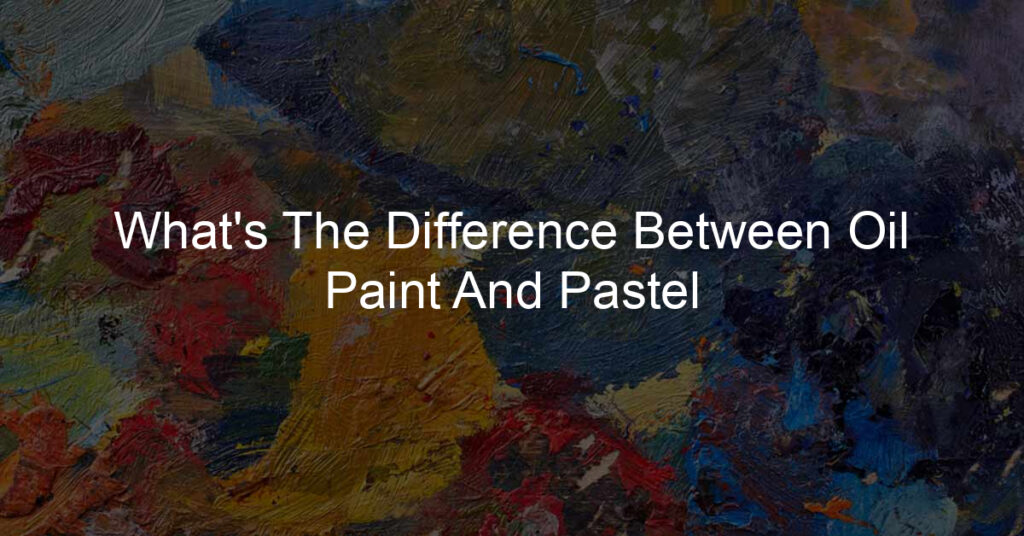Welcome to the colorful world of art! Today, we’re going to explore two popular mediums that artists use to create their masterpieces – oil paint and pastels. Both are unique in their own ways and understanding their differences can help you choose the right one for your next artwork.
- Overview of the topic
- Importance of understanding the differences
Difference Between Oil Paint and Pastel
Let’s dive into the world of colors and explore the differences between oil paint and pastel. We’ll start with oil paint, a favorite medium for many artists.
Oil Paint Characteristics
Oil paint is a type of slow-drying paint that consists of particles of pigment suspended in a drying oil, commonly linseed oil. The viscosity of the paint may be modified by the addition of a solvent such as turpentine or white spirit, and varnish may be added to increase the glossiness of the dried oil paint film.
- Composition and texture: Oil paints have a rich, creamy texture that allows for a lot of flexibility when it comes to creating different effects. They’re made by mixing pigments with an oil, like linseed oil. This gives them a unique, buttery feel. You can layer them thickly for a textured look, or thin them out with a solvent for a smoother finish. Learn more about oil paint composition on Wikipedia.
- Color intensity and blending: One of the biggest advantages of oil paint is its intense color. The oil in the paint helps to bring out the full richness of the pigments. Plus, oil paints blend beautifully. You can create subtle gradients and soft edges that are hard to achieve with other mediums.
- Drying time and finish: Oil paints take a long time to dry. This can be a benefit because it allows you to work on a painting over several sessions, making changes and adjustments as you go. However, it can also be a challenge if you’re in a hurry to finish a piece. Once dry, oil paints have a glossy finish that can be varnished to protect the painting.
Now that we’ve covered the characteristics of oil paint, let’s move on to pastels in the next section.
Pastel Characteristics
- Composition and texture: Pastels are made from pure powdered pigment and a binder. This composition gives them a soft, velvety texture that’s easy to work with. Unlike oil paints, pastels don’t require any solvents or mediums. They’re applied directly to the surface, creating a unique, tactile quality. Pastels can be used on a variety of surfaces, but they work best on slightly rough paper that can hold the pigment.
- Color intensity and blending: Pastels are known for their vibrant, intense colors. Because they’re made from pure pigment, the colors remain bright and don’t fade over time. Pastels can be easily blended together to create a wide range of hues and shades. You can use your fingers, a blending stump, or a piece of cloth to blend the colors together. This makes pastels a great choice for artists who love to experiment with color.
- Drying time and finish: One of the biggest advantages of pastels is that they don’t require any drying time. As soon as you apply the pastel to the surface, it’s dry. This allows you to work quickly and make changes on the fly. The finish of a pastel artwork can vary depending on how heavily you apply the pastel. Light applications will have a more matte finish, while heavier applications can create a slightly glossy effect. To protect your finished pastel artwork, it’s recommended to use a
- fixative spray.
Comparing Oil Paint and Pastel
When it comes to creating art, the medium you choose can make a big difference. Today, we’re going to compare oil paint and pastel, two popular choices among artists. Let’s start by looking at the benefits of oil paint.
Benefits of Oil Paint
Oil paint has been a favorite medium of artists for centuries, and for good reason. Here are some of the top benefits:
- Longevity and Durability
- Flexibility in Techniques
- Depth of Color
So, if you’re looking for a medium that’s durable, versatile, and rich in color, oil paint could be the perfect choice for you. In the next section, we’ll compare these benefits to those of pastels, so you can make an informed decision about which medium is right for you.
Benefits of Pastel
Let’s take a moment to appreciate the wonders of pastel art. Pastel, like oil paint, has its unique benefits that make it a favorite among many artists. Here are some of the top benefits:
- Immediate Color Payoff
- No Drying Time
- Easy to Correct and Adjust
In conclusion, pastels offer immediate color payoff, require no drying time, and are easy to correct and adjust. These benefits make pastels a versatile and user-friendly medium for artists of all levels. So why not give pastels a try? You might just find your new favorite art medium!

Using Oil Paint vs Pastel
When it comes to creating beautiful artwork, both oil paint and pastels have their unique charm. But, if you’re a fan of oil paint, there are some techniques that can help you make the most out of your art. Let’s dive in!
Oil Paint Techniques
Oil paint is a versatile medium that allows you to experiment with a variety of techniques. Here are some of the most popular ones:
- Layering and Glazing: This technique involves applying thin, transparent layers of paint on top of each other. The result is a luminous effect that can add depth and richness to your artwork. It’s like building a sandwich of colors, where each layer adds a new flavor!
- Impasto and Scumbling: Impasto is a technique where you apply the paint thickly, so it stands out from the canvas. It can add a 3D effect to your painting. Scumbling, on the other hand, is a method where you lightly brush a thin layer of lighter, opaque paint over a dried layer of paint. It’s like adding a misty veil to your painting, giving it a dreamy look.
- Wet-on-wet and Wet-on-dry: Wet-on-wet is a technique where you apply fresh paint onto still wet paint. It can create a smooth blend of colors, perfect for painting skies or soft backgrounds. Wet-on-dry is when you apply wet paint onto a dry layer of paint. This technique allows for more control and is great for adding details.
Remember, practice makes perfect! So, don’t be afraid to experiment with these techniques and see what works best for you. Happy painting!
Pastel Techniques
Just like oil paints, pastels also have some unique techniques that artists use to create stunning artwork. Let’s dive into some of the most popular ones:
- Blending and Layering: Blending is a technique where you mix different pastel colors directly on the canvas to create a new color or a smooth transition between two colors. Layering, on the other hand, involves applying one color on top of another. This can create a rich, complex color effect. It’s like making a rainbow cake, where each layer adds a new flavor!
- Feathering and Crosshatching: Feathering is a technique where you apply pastel in a light, wispy manner, much like a bird’s feathers. This can create a soft, airy effect. Crosshatching involves drawing intersecting sets of parallel lines. This can create a textured, woven effect. It’s like weaving a colorful blanket on your canvas!
- Scumbling and Stippling: Scumbling is a technique where you lightly rub or “scumble” pastel onto the canvas, creating a hazy, dreamy effect. Stippling involves applying pastel in small dots or “stipples”. This can create a textured, pointillist effect. It’s like sprinkling colorful confetti on your canvas!
These techniques can help you create a wide range of effects with pastels, from soft and dreamy to bold and textured. So, why not grab some pastels and start experimenting?

Case Studies: Artists Using Oil Paint and Pastel
Let’s dive into the world of art and explore how famous artists have used oil paint and pastels to create masterpieces. We’ll look at their works and see how they’ve utilized the unique characteristics of these mediums.
- Examples of famous artists and their works
- Vincent Van Gogh: Known for his bold and emotional style, Van Gogh often used oil paint to create vivid, textured pieces like “Starry Night.”
- Edgar Degas: This French artist was famous for his pastel works. His piece “Ballet Rehearsal” showcases the soft, blended effect that pastels can achieve.
- How they utilize the medium’s characteristics
- Van Gogh’s use of oil paint allowed him to create thick, textured brushstrokes. This added a sense of depth and movement to his works, making them feel alive.
- Degas, on the other hand, used pastels for their softness and blendability. He was able to create delicate, nuanced color transitions in his ballet scenes, capturing the grace and fluidity of the dancers.
These artists show us that whether you’re using oil paint or pastels, it’s all about how you harness the medium’s characteristics to express your unique artistic vision.
Conclusion: Oil Paint vs Pastel
Well, we’ve journeyed through the colorful world of oil paint and pastels, and it’s been quite the adventure! Now, let’s wrap things up by recapping what we’ve learned and helping you decide which medium is right for your art.
- Recap of the differences and benefits
- Choosing the right medium for your art
Whether you choose oil paint, pastels, or both, the most important thing is to have fun and express yourself. After all, that’s what art is all about!



















